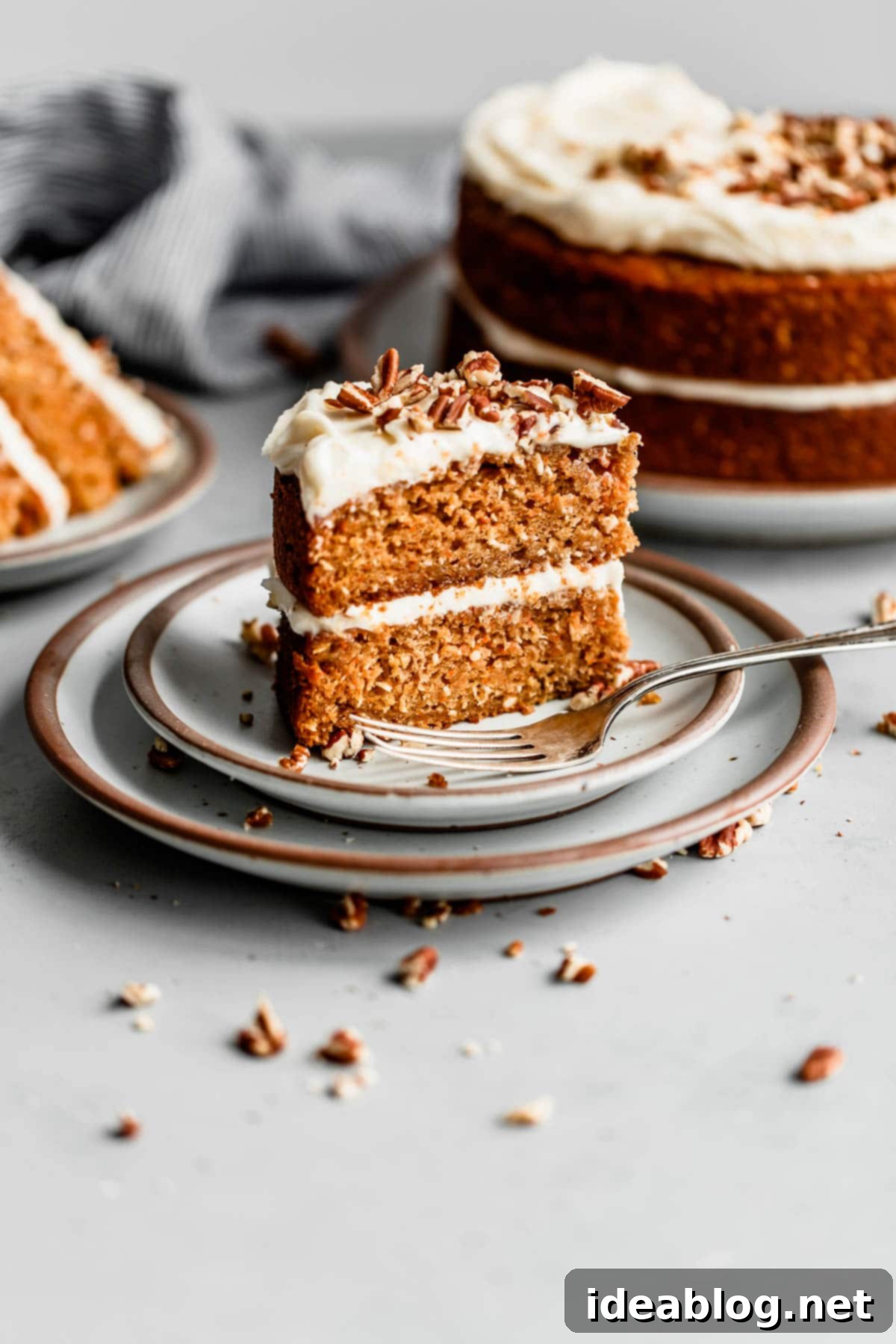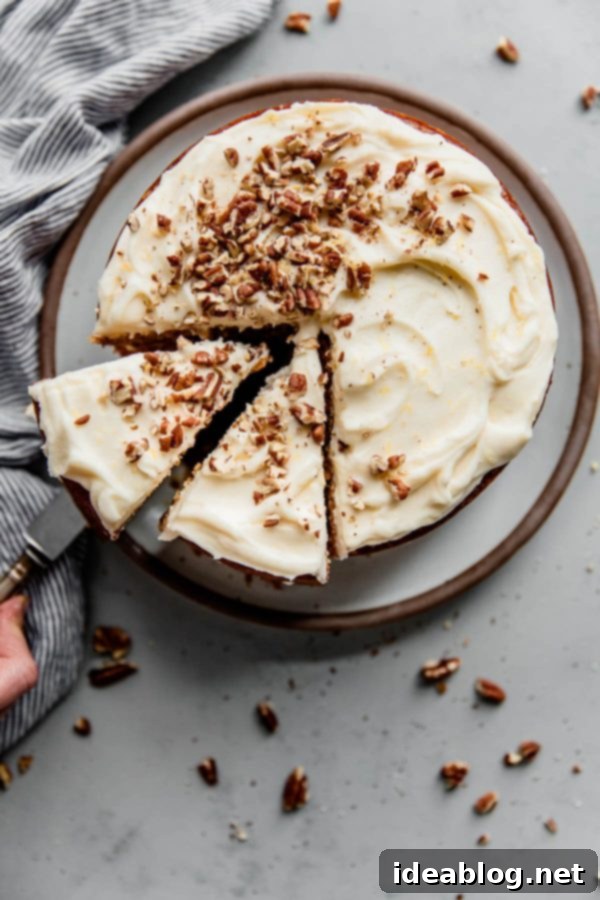Irresistibly Moist Carrot Cake with Pineapple, Coconut, and Zesty Lemon Cream Cheese Frosting: Your Ultimate Recipe
This exceptional carrot cake, featuring juicy pineapple and delicate coconut, is a triumph of texture and flavor. It’s incredibly moist, perfectly spiced, and remarkably easy to bake, making it the ideal dessert for Easter celebrations, holiday gatherings, or simply as a comforting treat any time of the year. Get ready to discover your new favorite carrot cake recipe!
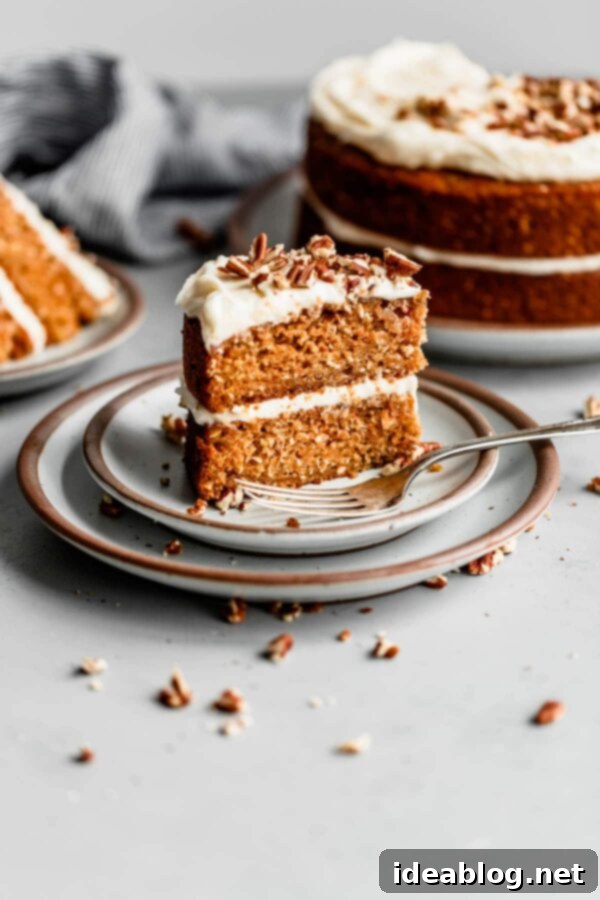
There are few desserts as universally adored and comforting as a classic carrot cake. And after a period of quiet, I can’t think of a more delightful way to reconnect than with a truly spectacular cake – not just any cake, but an utterly divine carrot cake crowned with a vibrant lemon cream cheese frosting! This recipe isn’t just about baking a cake; it’s about creating a memorable experience for you and your loved ones, a perfect centerpiece for any festive table or a simple indulgence on a cozy afternoon.
If you’ve been searching for the definitive, delicious, and classic dessert to serve during Easter weekend, or for any special occasion that calls for something truly outstanding, your search ends here. My love affair with carrot cake runs deep. When prepared with attention to detail and the right balance of ingredients, it stands as one of my all-time favorite cakes. As spring arrives with its promise of renewal and fresh flavors, my craving for this sweet, spiced, and utterly moist confection becomes irresistible.
Over the years, I’ve explored various delightful twists on this classic, from these cozy carrot cake scones to last year’s innovative carrot cake breakfast cookies. While those offered unique ways to enjoy the beloved flavors, today, I’m returning to the heart of what makes carrot cake truly special. I’m excited to share my absolute favorite, tried-and-true classic carrot cake recipe, meticulously perfected to deliver the ultimate balance of flavor, moisture, and ease.
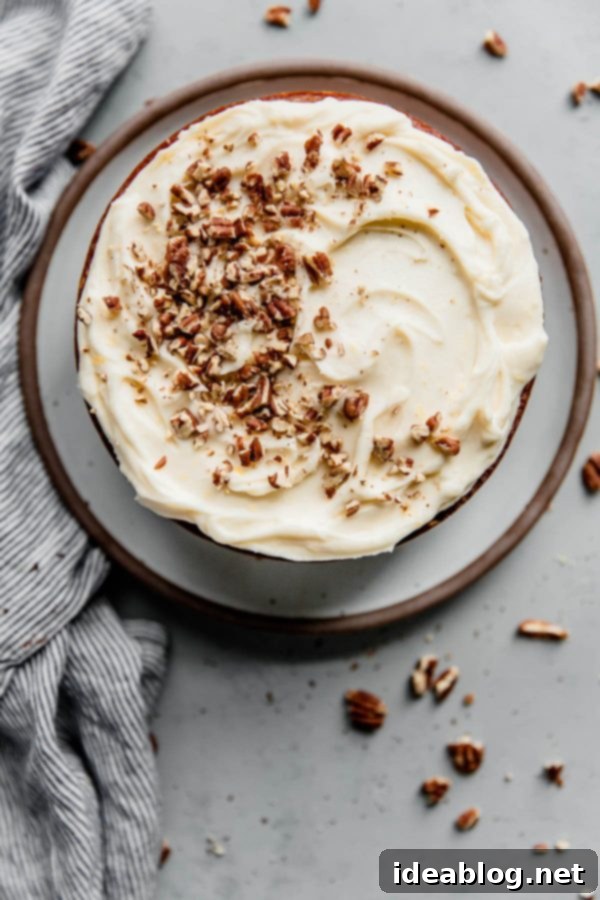
Why This Carrot Cake Recipe Will Become Your Favorite
This particular carrot cake stands out for several compelling reasons, promising a baking experience that’s as rewarding as the first delicious bite. It’s renowned for being incredibly moist – a quality attributed to a thoughtful selection of ingredients, which I’ll delve into shortly. Beyond its moisture, it’s generously packed with freshly grated carrots, imparting natural sweetness and a delightful texture. The subtle yet warming spices create a harmonious flavor profile, and perhaps best of all, the entire process is surprisingly easy to prepare, even for novice bakers.
One of the true beauties of this carrot cake is its remarkable ability to hold up beautifully over time. This means you can comfortably bake the cake layers and even assemble the entire cake well in advance of your event, freeing up precious time on the big day. And when it comes to leftovers (if you’re lucky enough to have any!), they remain wonderfully fresh and flavorful for days, making it an excellent choice for meal prepping desserts or simply enjoying a slice whenever the craving strikes.
In adherence to beloved tradition, this splendid cake is lavishly topped with a rich, tangy cream cheese frosting. For me, a carrot cake simply isn’t complete without this iconic pairing. I’ve taken the liberty of elevating this classic frosting by incorporating fresh lemon zest. This addition introduces a lovely brightness and a delicate citrus note that cuts through the richness of the cream cheese, perfectly complementing the sweet and earthy flavors of the carrot cake beneath. The contrast is simply exquisite.
You have the creative freedom to present this cake exactly as you like. Opt for a charming “naked cake” aesthetic, where the sides are left unfrosted to reveal the beautiful cake layers, or go all out and decorate the sides for a more traditional and elegant finish. The frosting recipe provides ample quantity to accommodate both styling preferences. This recipe consistently yields a magnificent 8-inch, two-layer cake, offering a generous 10 to 12 substantial portions – perfect for sharing with family and friends.
To add an extra layer of texture and a nutty crunch, I love to garnish the top of the cake with toasted, coarsely chopped pecans. However, feel free to customize this element to your liking. Chopped walnuts make an excellent substitute, or you can omit the nuts entirely if you prefer to make this a nut-free dessert, without sacrificing any of its inherent deliciousness.
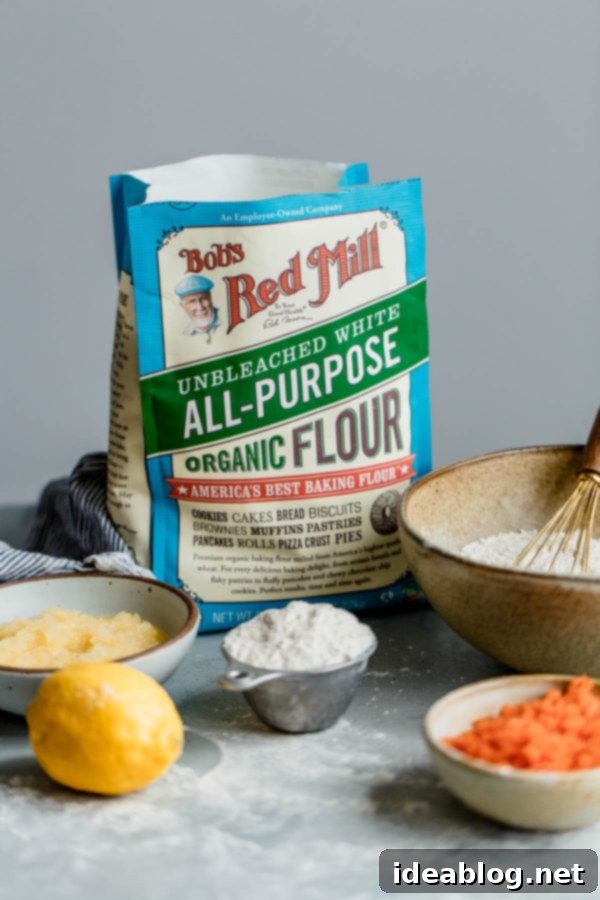
The Secret to Exceptional Texture: Bob’s Red Mill Organic Unbleached All-Purpose Flour
For today’s outstanding carrot cake recipe, I leaned on my trusted and consistently reliable everyday baking flour: Bob’s Red Mill Organic Unbleached All-Purpose Flour. Having partnered with Bob’s Red Mill for over four years, I can confidently say that their commitment to quality shines through in every product, and I cannot recommend them more highly for all your baking needs. Choosing the right flour is fundamental to the success of any baked good, and this one consistently delivers.
Bob’s Red Mill Organic Unbleached All-Purpose Flour is expertly milled from organic hard red wheat. It boasts a balanced protein content of 10% – 12%. This mid-range protein level is absolutely ideal for cakes, providing a delicate yet sturdy crumb that holds up beautifully. It allows for just enough gluten development to give structure without making the cake tough, resulting in a perfectly tender and moist texture that is the hallmark of a truly great carrot cake. Its versatility is unparalleled, making it a staple in my pantry for a wide array of recipes, from rustic breads to delicate pastries.
I always ensure I have this flour on hand because of its incredible versatility and the consistently excellent results it yields across so many applications. Its reliability is a baker’s dream. Furthermore, and equally important to me, Bob’s Red Mill flours are never bleached and contain absolutely no bromate (a chemical banned in many countries outside the United States) or other artificial chemicals. This dedication to natural, wholesome ingredients aligns perfectly with my baking philosophy. To deepen your understanding of how different flours impact your baking, I highly recommend reading more about the different types of baking flour.

The Unique Elements: Carrot Cake with Pineapple and Coconut Explained
So, what exactly sets this particular carrot cake recipe apart from the countless others out there? It’s all in the thoughtful combination and preparation of key ingredients that contribute to its exceptional flavor and unparalleled moisture.
This cake is designed to be perfectly sweet without being cloyingly so. The natural sweetness from the carrots and pineapple is balanced by warming spices and, crucially, the bright lift of lemon zest. It’s generously loaded with tons of freshly grated carrots, ensuring every bite is rich with flavor and delicate texture. And then there are the special additions: crushed pineapple and unsweetened shredded coconut, which transform this cake into something truly extraordinary.
I know, carrot cake with pineapple can be a bit controversial for some traditionalists. However, I urge you to try it just once. I promise, once you experience the incredible moisture, subtle tang, and complex flavor profile that pineapple brings to the table, you’ll be a convert. It adds that “something special” that truly elevates the cake from good to magnificent.
Expert Tips for Carrot Cake Success:
- Avocado (or Neutral Vegetable Oil): When baking cakes that boast a wealth of other robust and delicious ingredients, I consistently find that using oil as the primary baking fat yields superior results. Oil contributes to an incredibly moist cake crumb that maintains its tender quality for days, unlike butter which can sometimes lead to a drier texture over time. My preference is for avocado oil due to its neutral flavor profile, making it undetectable in the final cake, its nutritious fat content, and its high smoke point, which is beneficial for baking. However, any other neutral-flavored vegetable oil, such as canola or grapeseed oil, can be easily substituted with excellent results.
- Finely Grated Carrot: This recipe specifically calls for 2 and 1/2 cups of finely grated carrot, which typically amounts to about 4-5 large carrots. The key word here is “finely.” The fastest and most efficient method for achieving this fine texture is by utilizing the grating blade attachment of a food processor. To take it one step further and create an even finer grind, pulse the coarsely grated carrots several times in the food processor bowl with the regular blade attachment. This finer texture of the carrots is crucial; it ensures they blend seamlessly into the cake batter, contributing to a lighter, more delicate cake crumb and preventing any chunky, uneven textures.
- Drained, Pulsed Crushed Pineapple: The addition of crushed pineapple is a game-changer in carrot cake, infusing the cake with incredible moisture and a subtle, delightful acidity that brightens the overall flavor profile. For this recipe, you will need one cup of *drained* canned crushed pineapple (packed in its own juice). A fine-meshed sieve works wonderfully for thoroughly draining the pineapple. To truly integrate the pineapple and prevent any distinct lumps in the cake, we go an extra step: pulse the drained pineapple in a food processor until it achieves the smooth consistency of applesauce. This ensures that the pineapple’s moisture and flavor are evenly distributed throughout the cake batter, creating a harmonious and perfectly smooth texture without any unexpected pineapple chunks.
- Unsweetened Shredded Coconut: This ingredient is a delightful addition, contributing a delicate hint of natural coconut flavor that beautifully complements the other sweet and spiced notes in this cake. Beyond its subtle taste, the shredded coconut also adds a lovely, tender texture, enhancing the overall sensory experience of each bite without making the cake overly dense. Be sure to use unsweetened coconut to control the cake’s sweetness level effectively.
Note: For comprehensive visual guidance on how to meticulously prepare these key ingredients to perfection, including grating carrots and processing pineapple, please be sure to watch the detailed recipe video provided below.
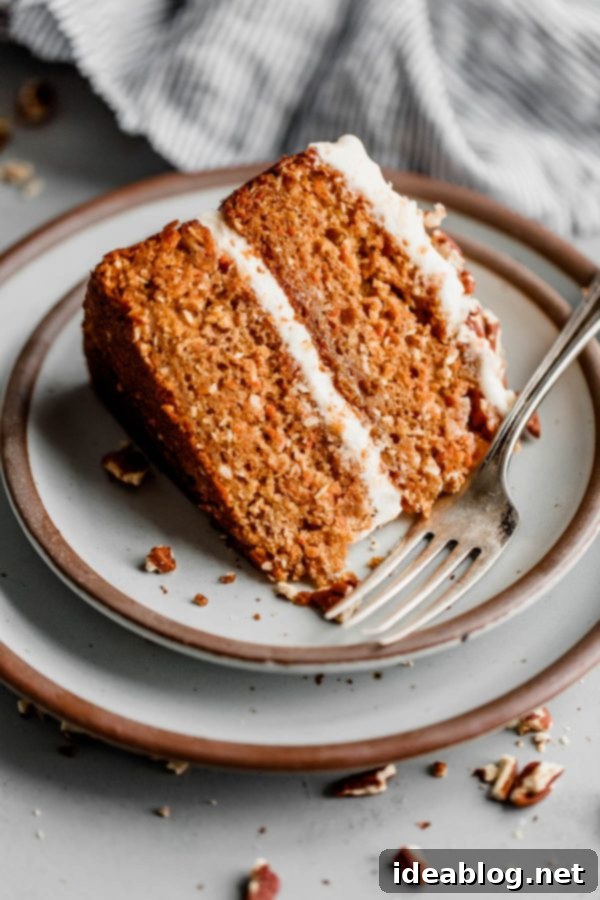
Throughout my culinary journey, I’ve experimented with carrot cake in countless iterations – some with nuts, some with raisins, and others with all sorts of additions. But without a doubt, the version with pineapple and coconut remains my undisputed, all-time favorite. It strikes a perfect balance that’s simply unmatched.
The crumb of this carrot cake is wonderfully tender and incredibly moist, a testament to the meticulous preparation of the finely grated carrot and delicate coconut. These ingredients not only contribute to the cake’s unique flavor but also its delightful, delicate texture. While the luscious lemon cream cheese frosting undeniably elevates the cake to another level of decadence, this cake is so inherently delicious that it tastes absolutely fantastic even on its own, showcasing the quality of its base ingredients.
It achieves that elusive sweet spot of being just sweet enough to be thoroughly enjoyed as a standalone treat, yet it’s never overly rich or heavy. This thoughtful balance ensures that the cake isn’t weighed down by the generous layer of cream cheese frosting, but rather harmonizes beautifully with it. Each bite offers a perfect symphony of flavors and textures, making it a truly unforgettable dessert that you’ll want to bake again and again.
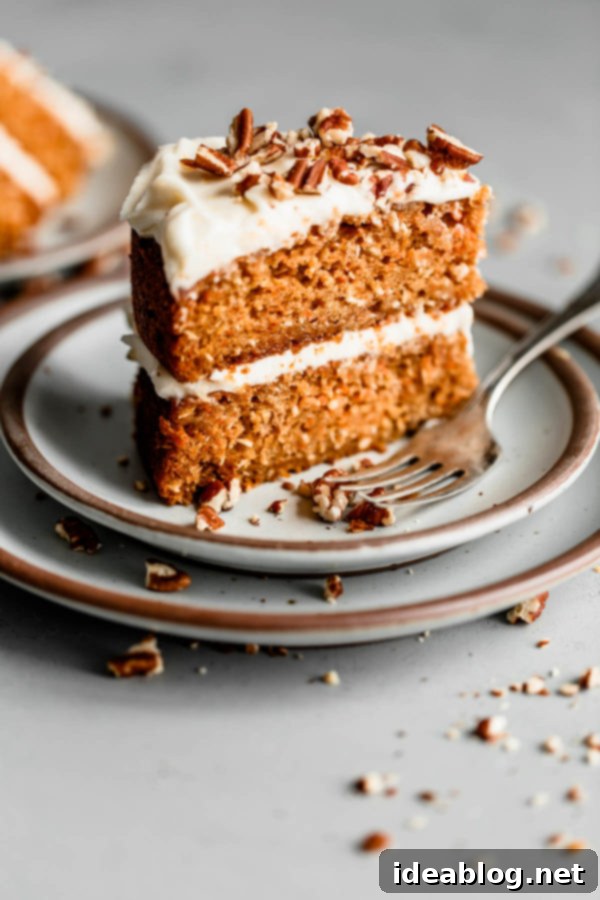

Carrot Cake with Lemon Cream Cheese Frosting
Pin
Review
SaveSaved!
Important Note: For the best results, pulsing the thoroughly drained crushed pineapple in a food processor is key. This step creates a smoother consistency, ensuring that the pineapple’s abundant moisture and subtle tang are evenly distributed throughout the cake batter. This technique prevents a coarser cake texture and guarantees a harmonious flavor in every bite. You will need just under one standard (20-ounce) can of crushed pineapple, packed in pineapple juice, to achieve the ideal quality and balance outlined in this recipe.
Equipment
-
Williams Sonoma Goldtouch® 8-Inch Nonstick Round Cake Pan
-
Magimix Food Processor
Ingredients
For the Carrot Cake:
- 2 cups (260g) Bob’s Red Mill Organic Unbleached All Purpose Flour
- 1¾ teaspoons baking soda
- 2 teaspoons ground cinnamon
- 1 teaspoon ground ginger
- ¾ teaspoon kosher salt
- 1¼ cups (250g) granulated sugar
- zest of 1 lemon
- 4 large eggs room temperature
- ½ cup (120 mL) avocado or vegetable oil
- 1 cup (225g) drained canned crushed pineapple, then pulsed in food processor until it reaches the consistency of thick applesauce *you will need just under one (20-ounce) can
- 2 teaspoons pure vanilla extract
- 2½ cups (315g) finely grated carrot (about 5-6 large peeled carrots) I use my food processor grating blade to grate, then pulse the grated carrots in a food processor to get a finer grind
- ½ cup (50g) Bob’s Red Mill unsweetened shredded coconut
For the Lemon Cream Cheese Frosting:
- 8 ounces (224g) full-fat block cream cheese softened to room temperature
- ¾ cup (6 oz; 170g) unsalted butter softened to room temperature
- ⅛ teaspoon kosher salt
- 1 teaspoon pure vanilla extract
- zest of 1 lemon
- 2¼ cups (270g) powdered sugar sifted to remove any lumps
For Garnishing:
- toasted pecans (optional) coarsely chopped
Instructions
-
Baking Note for Optimal Results: Before you begin, please carefully review the detailed preparation methods for both the crushed pineapple and finely grated carrot, as outlined in the ingredient list and the special “Tips for Success” section above. Adhering to these specific steps is crucial for achieving the incredibly moist texture and balanced flavor that defines this carrot cake.
-
To Prepare the Cake Layers: Begin by preheating your oven to a precise 350°F (180°C), ensuring an oven rack is positioned in the center. Thoroughly grease two 8-inch (20cm) round cake pans with baking spray, then line the bottoms with parchment paper rounds. This preparation ensures easy release and perfectly formed cake layers. Set the prepared pans aside.
-
In a medium-sized mixing bowl, meticulously whisk together the Bob’s Red Mill Organic Unbleached All-Purpose Flour, baking soda, ground cinnamon, ground ginger, and kosher salt. This dry mixture should be well combined to ensure even distribution of leavening and spices throughout the cake. Set this bowl aside.
-
In a generously sized mixing bowl, combine the granulated sugar and the fragrant lemon zest. Using your fingertips, vigorously rub the lemon zest into the sugar. This crucial step releases the essential oils from the zest, infusing the sugar with bright citrus aroma and flavor, making it moist and intensely fragrant. Next, add the room temperature eggs, avocado (or preferred neutral vegetable) oil, the puréed crushed pineapple, and the pure vanilla extract. Whisk these wet ingredients together until the mixture is completely smooth and noticeably thick, ensuring all components are thoroughly incorporated.
-
Carefully add the reserved dry flour mixture to the wet ingredients in two gradual additions. Using a stiff whisk, combine the ingredients until the flour has just been absorbed and no dry streaks or bits are visible. Be careful not to overmix at this stage. Finally, with a spatula, gently fold in the finely grated carrot and the unsweetened shredded coconut. Again, exercise caution to avoid overmixing, which can lead to a tough cake texture.
-
Divide the cake batter evenly between the two prepared cake pans. Use an offset spatula to gently smooth the top of the batter in each pan, ensuring an even bake. Transfer the pans to the preheated oven and bake for approximately 32 to 38 minutes. The cakes are done when they appear golden brown, the sides have just begun to pull away from the edges of the pan, and a toothpick inserted into the center comes out completely clean.
-
Once baked, allow the cakes to cool in their pans on a wire cooling rack for about 10 minutes. After this initial cooling, carefully invert the cakes onto the cooling rack, gently remove the parchment paper, and then invert them once more so that the top of each cake layer is facing upward. This allows for proper air circulation. It is essential to let the cake layers cool completely to room temperature before attempting to frost them. *Advance Preparation Note: If you wish to bake the cake layers ahead of time, allow them to cool completely as described. Then, wrap each layer tightly with plastic wrap to prevent drying and refrigerate for up to 2 days, or freeze for up to 2 months. Thaw frozen layers at room temperature for 12 to 24 hours before assembly.
-
To Prepare the Lemon Cream Cheese Frosting: In the bowl of a stand mixer fitted with a paddle attachment, combine the softened full-fat block cream cheese, softened unsalted butter, kosher salt, pure vanilla extract, and fresh lemon zest. Beat these ingredients together over medium-high speed until the mixture becomes wonderfully smooth and creamy. This should take approximately 30 seconds to 1 minute, ensuring no lumps remain.
-
Reduce the mixer speed to low and gradually add the sifted powdered sugar. Sifting is crucial here to prevent any lumps in your frosting. Once the sugar has been mostly absorbed into the wet ingredients, increase the mixer speed to medium-high and continue to beat until the frosting is light, smooth, and beautifully fluffy, which typically takes about 1 minute or so. Throughout this process, remember to scrape down the bottom and sides of the bowl with a spatula once or twice to ensure all ingredients are fully incorporated and the frosting is uniform.
-
To Assemble the Cake: Select the sturdiest and most even cake layer to serve as the base of your cake. Carefully place this layer on your chosen cake stand or cake board. Evenly spread a generous amount of the luscious cream cheese frosting over the top of this first cake layer. Gently place the remaining cake layer on top. Spread the remaining frosting on the top layer, using a small offset spatula to create elegant little swooshes or a smooth finish, as desired. Important Note: The provided cream cheese frosting recipe yields enough frosting for you to generously cover both the tops and the sides of this two-layer cake. Alternatively, you can choose to leave the sides of your cake “naked,” revealing the beautiful cake layers within – a style this cake beautifully supports due to its high moisture content and robust structure.
-
For an added touch of elegance and crunch, garnish the top of the cake with coarsely chopped toasted pecans, if desired. Slice the cake with a sharp knife and serve immediately for optimal freshness. If preparing ahead (which is highly recommended for convenience and flavor development), cover the assembled cake and refrigerate for up to 2 days. While the cake is best served within a day or so of baking, its high moisture level ensures it holds up exceptionally well and maintains its delicious flavor for 3 to 5 days after baking. Serving Tip: If you’ve refrigerated the cake, I recommend removing it from the refrigerator about 30 minutes before serving. I personally find that both the carrot cake and its cream cheese frosting are at their absolute best when they have a slight chill, allowing the flavors and textures to fully shine.
Video
Additional Tips for Baking Success:
- Achieving the perfect texture in this carrot cake relies heavily on the careful preparation of the crushed pineapple. Pulsing the thoroughly drained crushed pineapple in a food processor is essential. This step ensures a wonderfully smooth texture, allowing the pineapple’s moisture and bright acidity to distribute evenly throughout the cake batter without resulting in a coarser cake texture or unexpected chunks. You’ll typically need just under one standard (20-ounce) can of crushed pineapple, packed in its own juice, for the precise quality and consistency required by this recipe.
- For the best possible cake texture, the carrots need to be finely grated. I highly recommend using the grating blade of a large food processor for speed and consistency. After grating, take an extra step: pulse the grated carrot in the food processor bowl with the regular blade attachment a few more times. This creates a much finer grind, ensuring the carrots melt into the cake, contributing to a lighter, more tender crumb and preventing any undesirable stringiness.
- This carrot cake is a fantastic make-ahead dessert. If you’re preparing the cake layers in advance, allow them to cool completely on a wire rack after baking. Once cooled, wrap each layer tightly with plastic wrap to prevent them from drying out. They can then be refrigerated for up to 2 days, or frozen for up to 2 months. If frozen, remember to allow the cake layers to thaw at room temperature for a generous 12 to 24 hours before you plan to assemble and frost the cake. While the cake is delicious fresh, its exceptional moisture content means it tastes incredibly good and holds up beautifully for 3 to 5 days after baking, making it perfect for entertaining.

